The traditional modern lama
January 16, 2020 2
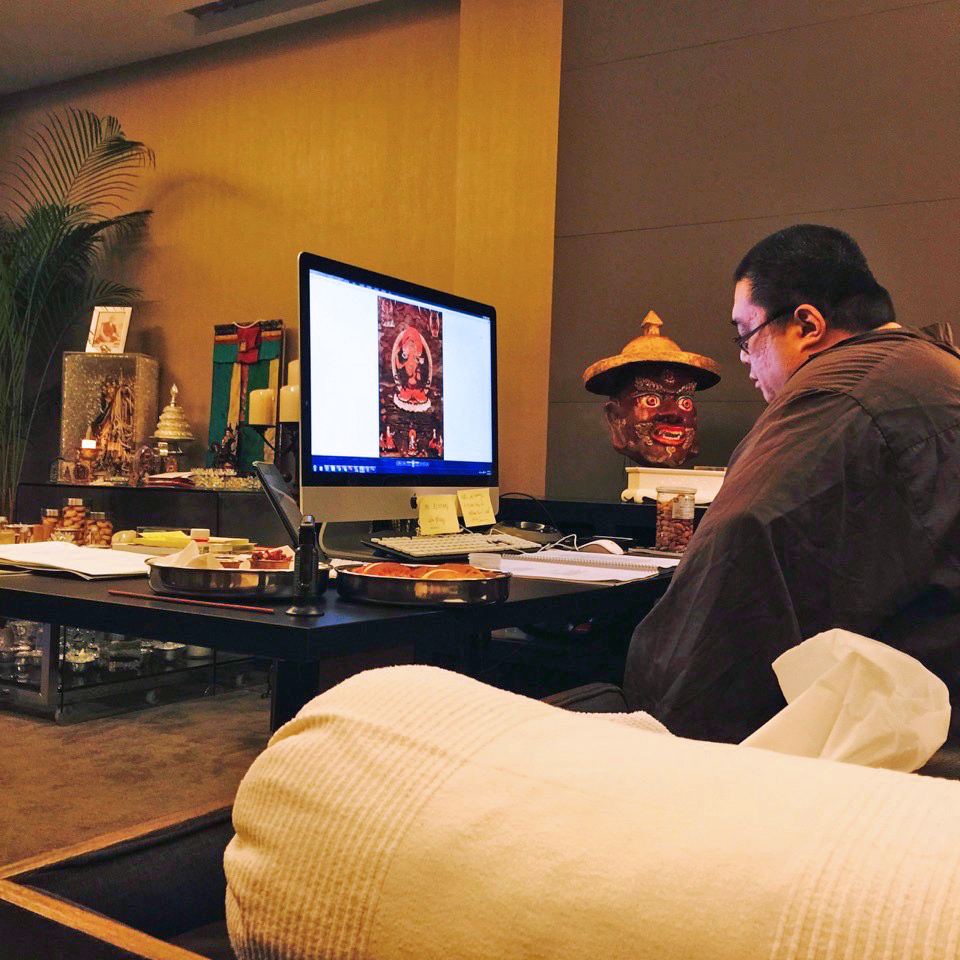
Tsem Rinpoche offering tsok.
First of all, what is tsok (Sanskrit: ganachakra)? According to Rinpoche,
Tsok happens twice a month every month. It is a special day where the dakinis of the 24 holy places gather together to bless the tantric practitioner‘s body, nerves, chi, chakras, speech and mind. On Tsok Day we can perform a special tsok to our yidam or a general tsok for all the Three Jewels (Lama Chopa). Tsok gathers tremendous amounts of merits to support our tantric meditations in order to get results.
Tsok tradition was started (from Buddha) in Ancient Indian Buddhism by the great Buddhist Mahasiddhas such as Tilopa and Naropa, etc. It was brought to Tibet as a means for tantrikas who have little means to gather great merits in order to gain attainments. Atisha and Guru Rinpoche shared Tsok practice with the Tibetans 1,000 years ago. Once you receive higher tantra initiation, you must perform tsok twice a month for life. Today is Tsok Day and the tantrikas gather at Kechara to perform Lama Chopa like they do twice every month.
In many respects, Rinpoche was extremely modern. The most famous, obvious example would be Rinpoche’s blog, with Rinpoche being one of the first lamas to recognise the potential of the Internet. Rinpoche realised that in remote, isolated places, people might not have easy access to the Dharma centre or teacher. The Internet however, could reach every single corner of the globe, from the comfort of our homes; Rinpoche said that with the keyboard, we could be like a 1000-Armed Chenrezig reaching out to benefit others. For this reason (amongst many others!), Rinpoche set up the blog to preserve the teachings and provide them for free.
Rinpoche’s intuition, as usual, proved to be correct. Soon, Rinpoche started getting emails from practitioners in small towns all over Eastern Europe, Latin America, etc. expressing their gratitude for the blog because their nearest centre or lama was a few hours away. Rinpoche would always reply saying if they ever had any questions, to feel free to ask and Rinpoche would do his best to reply to them. They did not even have to be the same lineage or tradition, or be Rinpoche’s student; from one Dharma practitioner to another, Rinpoche just wanted to share with them and help them as best Rinpoche could.
Then, when YouTube was just starting up, a student brought it to Rinpoche’s attention. Soon, Rinpoche was recording countless video teachings and posting them up online. When live-streaming started to become popular, Rinpoche realised it would be another good medium to spread the Dharma so we started doing that. It was Rinpoche who got us started on using bit.ly links “because they look neater”.
Everyone knows that when Rinpoche had a phone, Rinpoche would disseminate teachings by text but what many do not know is that when Rinpoche got an iPhone, Rinpoche would also FaceTime and video call some students. That was always a surprise, albeit one that did not last for long since Rinpoche soon switched to another phone! Anyway, it was Rinpoche who recognised the power of social media, getting accounts set up and instructing for students to go online and engage with others in Dharma sharings. When Rinpoche saw that social media was becoming much more visually based, that is where Rinpoche had us turn out focus to.
It was Rinpoche who thought it would be possible to implement a blog chat, who conceptualised the idea of Photos on the Go and Videos on the Go, and who wanted to enable the use of stickers and uploading of images in the blog comments section.
It may surprise some to know that Rinpoche never learned any of this formally, read any books on it nor attended any classes. Rinpoche said it was all common sense to him; Rinpoche could not describe to us exactly how it worked but Rinpoche said when he surveyed the situation before him, Rinpoche could see how this piece fit in with this, and with that, and how it could all come together for a particular result. Rinpoche did not know how it would work technically but just knew that it was possible and so it would be up to us, the students, to figure out how to get it done.
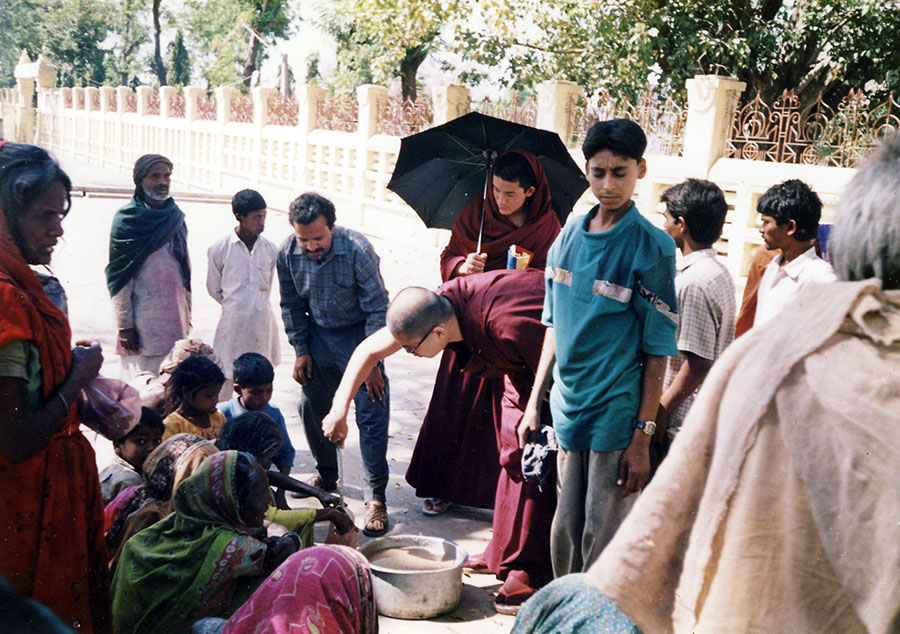
Rinpoche offering food to homeless men, women and children decades ago in India. Back then, Rinpoche had next to no money and yet still raised funds to feed the poor.
Offline, Rinpoche established a Himalayan arts studio in Malaysia, the first of its kind. Rinpoche was also really a Buddhist pioneer when it came to soup kitchens, and getting people engaged in active compassion. It started back when Rinpoche was living in India, and feeding poor Tibetan refugees and Indian beggars even though Rinpoche himself had next to no money. Because of Rinpoche’s own experiences as a homeless teenager, Rinpoche was inspired to make sure no one ever feels the same sense of hopelessness and set up Kechara Soup Kitchen. It now serves 100,000 people every year, 800 families every month, and 295 NGOs and shelters nationwide.
So how does all of this tie in with Rinpoche offering tsok?
Because in spite of how modern Rinpoche was, there were also things that Rinpoche was absolutely traditional about, things that Rinpoche never, ever compromised on. When it came to commitments, guru devotion, daily practices and prayers, tantra and the teachings, Rinpoche was very traditional about them.
For example, up till the day Rinpoche passed, not a single person ever learned who Rinpoche’s yidam was. A yidam is your meditational deity, the Buddha with whom you have the strongest karmic connection. So you focus on their practice and learn how to connect with them, and make them your heart practice.
Traditionally, your yidam was assigned during an initiation into their practice, and who they are is never revealed to anyone else. That knowledge is purely between you and the initiating lama, as well as the one or two other people receiving the initiation at the same time. If you ever had any questions about the practice, you could only clarify them with the few who know who your yidam is.
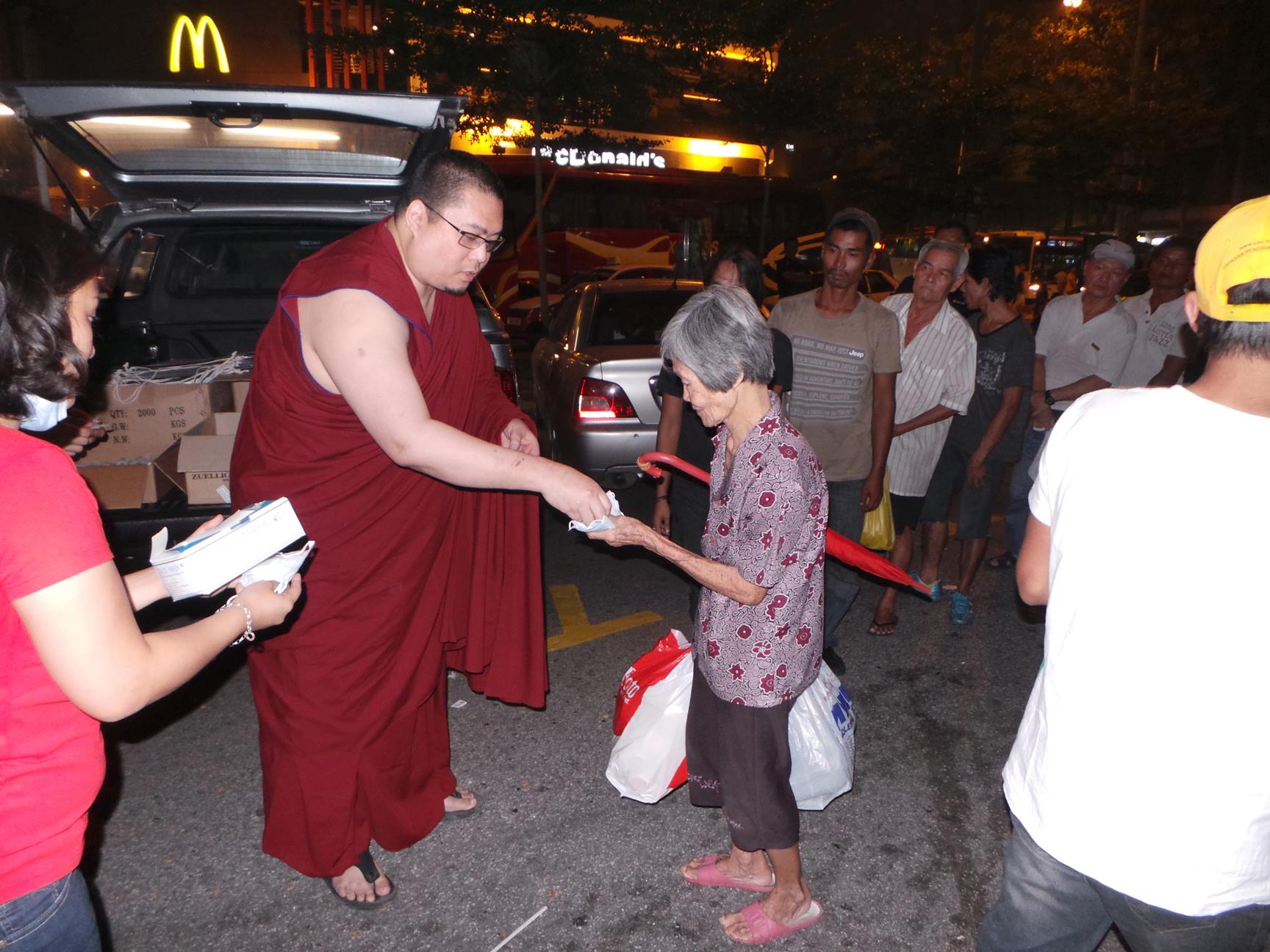
Rinpoche distributing face masks and eye drops to the homeless during a particular bad haze in Kuala Lumpur
Furthermore, traditional practitioners would not show an image of their yidam to anyone else. If they needed an image for practice and there was absolutely no way to keep it hidden, it was permissible for the original image to be kept hidden behind a copy, and for the practitioner to think, “That original image has not been seen by anyone else, my commitments are still intact”. It is even permissible for practitioners to ‘lie’ when asked who their yidam is. Rinpoche said he knew of old lamas who claimed their yidam to be Lama Tsongkhapa when it so clearly and obviously was not the case.
So traditionally speaking, yidam practice was very, very strict. That situation however, is so very different for many people these days who cannot wait to talk about who their yidam is.
“My yidam is such-and-such, I received this initiation in (insert year).”
“I practise such-and-such, what do you practise?”
“I got such-and-such yidam from this lama, what did you get?”
It was not like that with Rinpoche. Rinpoche once told us that throughout Kechara, there is not a single depiction of Rinpoche’s yidam anywhere. Not a photocopied image, no thangka, no statue, not a single written word about them, nothing.
When we heard this, like the group of clowns we are, we immediately started guessing and of course, Rinpoche said, “Nope” to every single one of them.
Vajra Yogini? Nope!
Cittamani Tara? Nope!
Yamantaka? Nope!
Foolishly, I thought I had a pretty good shot since I was responsible for maintaining Rinpoche’s sadhana book. That is when Rinpoche told us his yidam practice is not even in his sadhana book. As per tradition, Rinpoche had received the practice, memorised it and had never written it down anywhere.
It was hard not to feel completely overwhelmed with faith at that point. For all of Rinpoche’s modern leanings, hearing that immediately made it feel like we were meeting the masters of old who we always read about, who are so disciplined in their adherence to the tantric rules. I remember thinking, “What a Kadampa master” because even if we had guessed correctly, Rinpoche would never have said ‘yes’ or shown any hint of acknowledgement that we might have hit on the correct one.
There was no showing off, no boasting about what higher tantric initiation Rinpoche had received. Rinpoche did not need anyone else to know what he had received; it was enough for Rinpoche that the knowledge remained between Rinpoche and the initiating lama. Receiving the practice was not about ego, but it was about attainments.
And so no one ever learned who Rinpoche’s yidam was. While everyone assumes it was Vajra Yogini, it was not (according to Rinpoche anyway!). Rinpoche said Vajra Yogini was not for him and like any prayers in Rinpoche’s sadhana, all of those practices (including her) were for us. Rinpoche maintained all of his sadhanic commitments, like Vajra Yogini, in order to pass the practices on to others; to ensure the blessings were not broken, Rinpoche did his sadhana every single day. As part of this routine, every two weeks, Rinpoche would offer tsok.
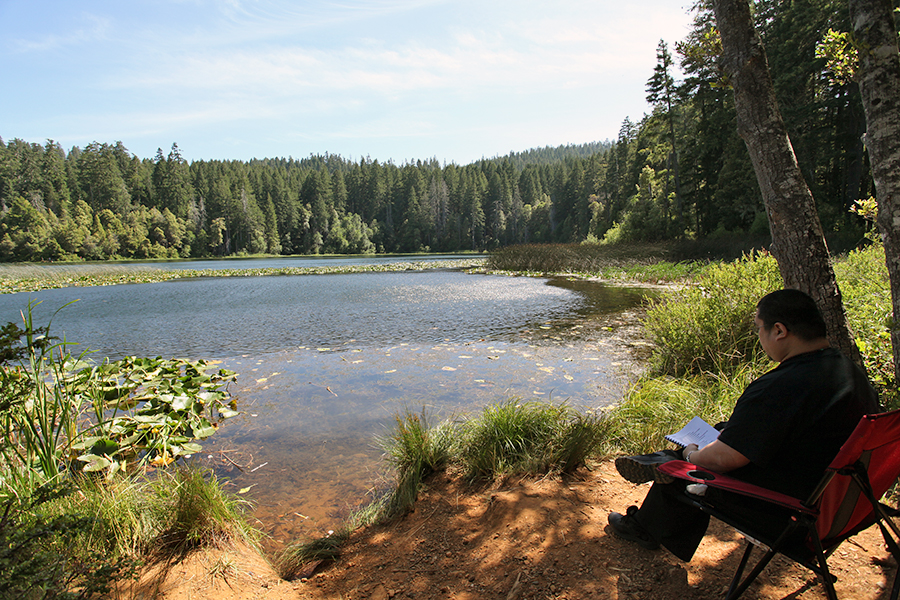
Rinpoche doing his sadhana at Fish Lake in Six Rivers National Forest (Humboldt County, North California). Rinpoche really savoured the opportunity, stopped every so often just to appreciate and take in the scene before him.
Rinpoche would offer tsok come rain or shine. Students would set up the altar and tsok offerings, inform Rinpoche and be on standby to assist during the rituals.
There were times when Rinpoche had to deal with an urgent matter and after a long audience with guests helping solve their problems, Rinpoche would take a nap and ask to be woken up to offer tsok. There were times when Rinpoche had a fever or a migraine, and still sit up and offer tsok and do his sadhana. We have seen Rinpoche doing his sadhana on a plane, in a bus, in the car, in the mountains, on the beach, in the forest…basically, anywhere you can imagine except for the bathroom.
Where most of us would think, “I’ll just catch up tomorrow” when it gets too late in the day, Rinpoche always thought, “What if tomorrow never comes?” Rinpoche once said that if he does not wake up, Rinpoche wants the last thing he did before falling asleep to have been his sadhana. That is how important Rinpoche’s sadhana was, and it is this same tenacity Rinpoche applied to fulfilling his sadhanic commitments, that Rinpoche applied to every other aspect of his life and work, that means we now have the privilege of Kechara.
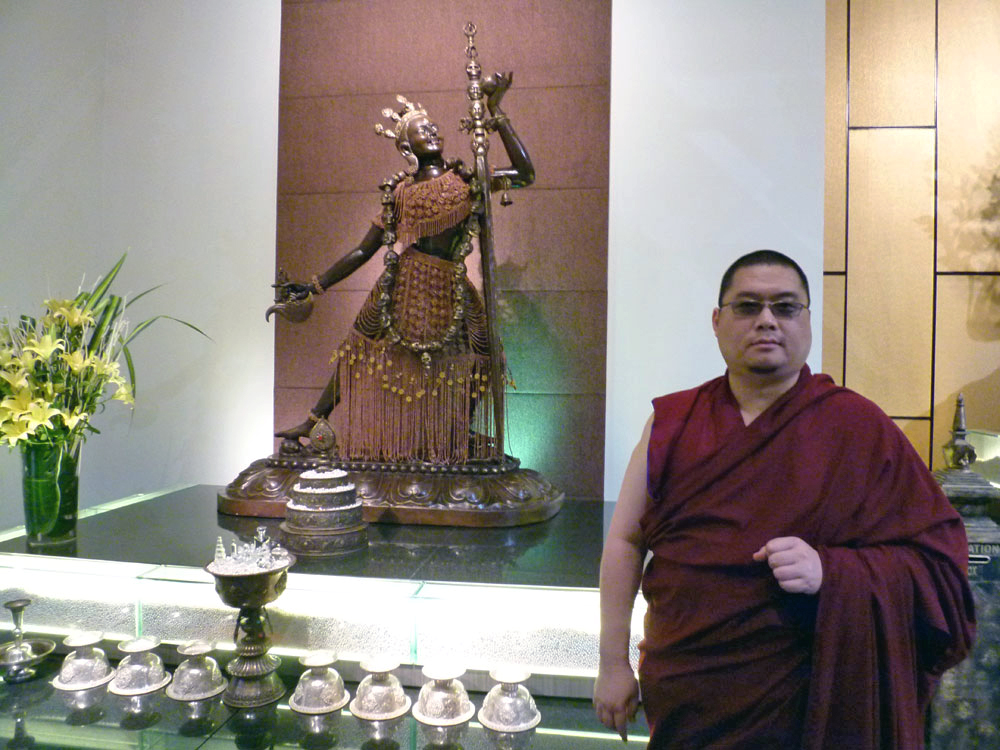
Aside from reasons of guru devotion, Rinpoche said he maintained his commitments and his practice of Vajra Yogini to pass onto others
It stands to reason that the level of consistency and commitment we apply to our sadhana, will reflect the level of success we achieve both spiritually and secularly because that is what consistency is, the cornerstone for success. If you can be consistent in your sadhana, you can be consistent elsewhere in your life. If you are not consistent in your sadhana, chances are you will not be consistent in other areas of your life.
Not only is consistency important but as the years pass, Rinpoche advised that our sadhana should grow not only in length but in depth as well. If our sadhana is short, fine but do it well and do it consistently. Rinpoche taught that we should learn to be really engaged in our sadhana, not reciting it for the sake of completion but to do the visualisations properly, to meditate at the appropriate junctures, and do our sadhana well for the sake of attainments.
To illustrate the importance of doing our sadhana, Rinpoche said, “If His Holiness Kyabje Trijang Rinpoche and His Holiness Kyabje Zong Rinpoche did their sadhanas every day and they are Buddhas, who are we to not do our sadhanas?” In reality, the statement works just as well for our Rinpoche and so I posit to you,
“If His Eminence Kyabje Tsem Tulku Rinpoche did his sadhana every day and he is a Buddha, who are we to not do our sadhanas?”
To my Lama, who is one with Heruka, we look forward to welcoming you home soon.
2 Comments → “The traditional modern lama”
Leave a Reply Cancel reply
Recent Posts
Subscribe to Blog
Categories
Archives
Visitors by Country
| Total Pageviews: | 1 |
|---|



It got me thinking… Pastor mentioned this repeatedly ‘ To my Lama, who is one with Heruka, we look forward to welcoming you home soon.’ in almost every blog post since Rinpoche is ‘away’. I think that’s the hint right?
Hi Jacinta,
That was inspired by a prayer composed by one of the lamas, for us to request for Rinpoche’s swift return. Whether it is Heruka or not, is not confirmed 🙂